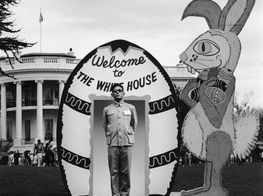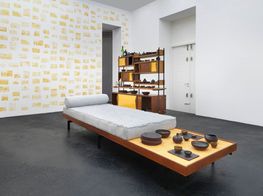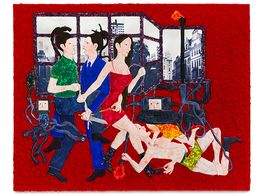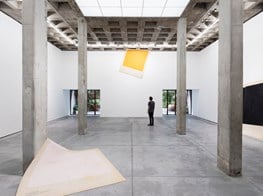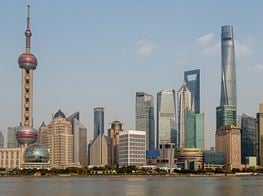This Market Of Mine: Final Reflections On An Art Fair Week
Art Basel in Hong Kong has been, by all accounts, a success. Of course, no one would have expected anything less from Hong Kong, a city Milton Friedman once held up as a prime example of a “perfect” capitalist society. Perhaps it was this context that made the market a key point of contention at ABHK. It all came to a head on Friday evening, when Intelligence Squared (IQ2) staged its anticipated debate: The Market is the Best Judge of Art’s Quality in the Hong Kong Convention Centre.
Amy Cappellazzo, Chairman of Postwar and Contemporary Development at Christie’s and Jeffrey Deitch, Director of LA’s MOCA, were for the motion, countered by artists Matthew Collings and Rirkrit Tiravanija. Moderating was Artforum co-publisher Charles Guarino, who remained in the undecided category both in the pre- and post- debate vote. (Pre: 20% for, 60% against and 20% didn’t know. Post: 73% against, 25% for, and 2% didn’t know.)
Introducing the debate, Guarino drew parallels between Manhattan (“an island nation with a central government that doesn’t understand it”) and Hong Kong – a capitalist city that forms a Special Administrative Region of China, defined (and protected) by a “one country two systems policy.” Hong Kong is a city with a business district located on an island, just like New York City.
Art Basel, as a very specific kind of market place, is not unlike Manhattan and Hong Kong Island. It is a trading hub just as New York and Hong Kong are market cities: capitalist to the core and considered by its inhabitants as entirely separate to the countries to which they belong.
You could also look at Art Basel – or any art fair – as a semi-autonomous zone: a market place where global traders might enact the art of buying and selling within the context of free market capitalism. This isn’t necessarily a bad thing. In Hong Kong, market culture has always been a part of local life, just as in cultures around the world. As Cappellazzo noted, a trader fair is a souk. The market has always been there. And, as Jeffrey Deitch said during the debate: the market is an ancient thing. Similarily, when Cappellazzo was asked whether a community without an art market would then be deemed to have no sense of quality, she said: even in the market’s absence, humans will always produce an organic system of sorting.
But if, like Matthew Collings, you’ve been to one art fair too many, it’s easy to become jaded. Collings began his elegant and heartfelt rant at the IQ2 debate with a clarification: “The aim of the market is simple,” Collings noted. “Marketing.”
As Holland Cotter observed of Frieze New York 2012, people come to art fairs even if they hate them – there is a sort of Stockholm Syndrome made worse by the fact that ultimately, as Tiravanija noted, quoting artist Ad Reinhardt: “Art as a commodity is an ugly idea.”
Collings’s point chimed with Rirkrit Tiravanija’s presentation, when he recalled the moment the art world became branded “and artists were branded along with that.” This is a reality many an artist (and any other art world player) faces today when thinking about how, as Ben Davis of Artinfo.com once observed in 2012, the art fair has become the new event-based way art is experienced in the 21st Century.
But this has produced a strange reality. As Holland Cotter observed of Frieze New York 2012, people come to art fairs even if they hate them – there is a sort of Stockholm Syndrome made worse by the fact that ultimately, as Tiravanija noted quoting artist Ad Reinhardt: “Art as a commodity is an ugly idea.”
Nevertheless, we need these spaces, because they represent one part of the eco-system to which we belong: the art world. And in the art fair, as ugly as it can be, there are moments of beauty, too: Sikkema Jenkins & Co. showing Kara Walker and Arlene Sechet; Shimabuku’s Octopus Stone (2013) at Wilkinson; Navid Nuur and Adrian Ghenie at PLAN B, for instance. Walk around Hong Kong and you will see the same sort of glimpses: Banyan trees growing out of walls, breaking up pavements, local markets inserting themselves in between mighty high-rises; an irrepressible street culture.
This is market life in a market city; and Hong Kong people live within it, negotiating what this means on a social and political level. The way we move in art fairs is no different; we are politicized, marketized and problematized just as much as when we are faced with a city that bends to the will of the economy more than to its people.
In the fair, Shanghai Gallery of Art presented Rirkrit Tiravanija's Untitled (Same But Not Equal) (2013): the statement printed on canvas. The work complicates a number of things: namely, the idea that the art market is the ultimate measure of a work’s quality due to its ability to quantify art while also remaining un-indexable, when taking into account that these quantifications are predominately being enacted by a wealthy elite in an arguably elitist space (ticket prices pretty much priced out the local public). Added Value (2012), a work by Gao Weigang also on show at Shanghai Gallery of Art, plays on the prestige and value attached to works within the market system. It is a painting of the moment the artist received the ART FUTURES prize at ArtHK in 2011, the certificate framed and hung on the canvas itself.
Returning to Tiravanija’s piece, the dynamic flow and flux of the neoliberal economy – as Foucault discussed when talking about the circulation, valuation and control of the grain market, for instance – comes to mind. The canvas sits on two separate piles of rice; one, low-grade and the other, premium stuff. They look the same, but their value is different: like people, like artworks. All “same” but certainly not equal.
At the end of the IQ2 debate, it was decided that the market is not “the best judge” of art’s “quality”, though it is a valid judge, nevertheless. In thinking about who or what is the best judge of art’s quality, Tiravanija answered: “I’m a great believer in people.”
Of course: the market wouldn’t even exist if it weren’t for the people who activate it: you, me, Deitch, Cappellazzo and all the other members of art’s economy (collectors and critics included). Ultimately, the art market is our market, and we are the ones who determine its function. - [O]




